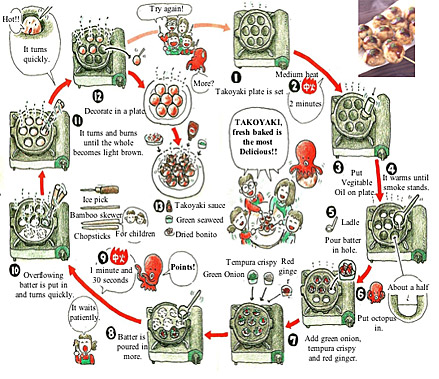Itadakimasu: A Haiku for Takoyaki
“Itadakimasu”
welcome to our feast
give thanks, take thanks, we are one
creamy cosmic tang
I’m not sure how this all started, if there even is a beginning. There’s something about food, things from the earth and the sea and the air, that have a primordial element to them when mixed with fire. Or at least I tend to think so. The five fundamentals of the cosmos mixed together in perfect balance–or at least that’s the idea. Sure, you burn things now and then, but such is life. Anyway, there is an interesting story here, believe it or not, that’s I’m going to share, in the hopes that it makes someone else chuckle besides me.
The Backstory
I’ve recently found myself doing some culinary experiments with various takoyaki recipes in my kitchen, and in the process have had quite an adventure. It all began early this week when I decided to break out my takoyaki maker from the kitchen closet and put it in action. The experiment went ok, but the batter I made didn’t really turn out how I had wanted. It was too doughy and dense, and without enough fluff. So it was back to trial and error kitchen research round 2.
The adventures continued soon after with a visit to Kenka, probably the single best (Japanese) culinary experience in the East Village, and maybe the whole dam East Coast. They also make the tastiest takoyaki I’ve ever had–so good I had to get seconds. After all, this was a culinary ethnographic experience par excellence to study the takoyaki tricks at Kenka up close and personal.
Now for those not familiar with takoyaki (たこ焼き), it’s basically a Japanese octopus dumpling in a round ball shape–a small cooked ball of egg, dough, puffed rice or tempura crumbles, any added flavors of your choice, and finally small pieces of octopus. In Japanese tako means octopus and yaki is a description of how the dish was made–grilled or fried, so basically this is a fried octopus ball (much like a dumpling as I said before).
 How did I end up at Itadakimasu? Well, you see, I was writing out a new recipe for takoyaki based on the takoyaki mix I picked up today at Midoriya, the localish Japanese grocery store near me–localish as I walk by it from the Bedford L stop, but not quite in “my” neighborhood per se. Anyway, I had been meaning to pick up some Japanese mayo–“QP Kewpie” in honor of Hijikata*–and see if they had any different options for flours or mixes for making takoyaki.
How did I end up at Itadakimasu? Well, you see, I was writing out a new recipe for takoyaki based on the takoyaki mix I picked up today at Midoriya, the localish Japanese grocery store near me–localish as I walk by it from the Bedford L stop, but not quite in “my” neighborhood per se. Anyway, I had been meaning to pick up some Japanese mayo–“QP Kewpie” in honor of Hijikata*–and see if they had any different options for flours or mixes for making takoyaki.
*For those who don’t know what I am talking about, Toshiro Hijikata (below on left) is a character from the manga/anime Gintama, who has a thing for mayo. If you watch the series, you know the deal. If you don’t know what I’m talking about, then you should read/watch Gintama. It’s seriously one of my favorite series. Both the manga and the anime are great–and how about those Neo Armstrong Cyclone Jet Armstrong Cannon moments…it’s otakulicious. Anyway, back to the story.
Here’s a snippet of the Wikipedia entry linked to itadakimasu that really grabbed me tonight, as I was double checking the hiragana spelling:
Eating and drinking
Meals in Japan traditionally begin with the phrase itadakimasu (いただきます?) (literally, “I humbly receive”). The phrase is similar to “bon appétit”, or saying grace to give thanks before a meal. It is said to express gratitude for all who played a role in preparing, cultivating, ranching or hunting the food. This also acknowledges that living organisms have given their life to human beings as Dāna.[1][2] Upon finishing a meal, the Japanese also use the polite phrase Gochisōsama-deshita (ごちそうさまでした?) (lit. You were a Feast (preparer)). Sama is the honorific word which gives respect to the person, therefore, this phrase gives respect for making the meal. It is considered polite to clear one’s plate, down to the very last grain of rice; children are especially encouraged to do so – see also mottainai as Buddhist philosophy. It is impolite to pick out certain ingredients and leave the rest. One should chew with the mouth closed.
What really caught my attention was this: “It is said to express gratitude for all who played a role in preparing, cultivating, ranching or hunting the food. This also acknowledges that living organisms have given their life to human beings as Dāna.” Now Dāna is an idea in Buddhism and Hinduism meaning something which “has the effect of purifying and transforming the mind of the giver.” The Hindu idea has too many problems because of the backward caste system it is embedded in, but the more general Buddhist idea worth holding onto here is linked to practices of hospitality, generosity and spiritual enlightenment–aka the act of “unattached and unconditional generosity” of giving and letting go of material possessions and desires. While I’m not a Buddhist, the idea also reminded me a bit of a potlatch, or a potluck as Americans tend to call it. In the Buddhist version, the basic idea is linked to the idea of paramitas, or what they call the “6 Perfections“:
- Dana paramita, perfection of giving
- Shila paramita, perfection of discipline
- Kshanti paramita, perfection of patience
- Virya paramita, perfection of exertion
- Dhyana paramita, perfection of meditation
- Prajna paramita, perfection of wisdom
For some reason this also reminded me of an idea Jacques Derrida discusses–hospitality. See for example his writing Of Hospitality, but also here or here, although he is less focused on food.
“It is as though hospitality were the impossible: as though the law of hospitality defined this very impossibility, as if it were only possible to transgress it, as though the law of absolute, as though the categorical imperative of hospitality commanded that we transgress all the laws (in the plural) of hospitality, namely, the conditions, the norms, the rights and the duties that are imposed on hosts and hostesses, on the men or women who give a welcome as well as the men and the women who receive it. And vice versa, it is as though the laws (plural) of hospitality, in marking limits, powers, rights, and duties, consisted in challenging and transgressing the law of hospitality, the one that would command that the “new arrival” be offered an unconditional welcome.” (OH 75)
As you can see above, the round two experiment earlier this evening was much more a success. The takoyaki batter made wonders of difference, like, 200x difference. So future reference, run of the mill wheat flour–no good, just in case there is any doubt. Also, these finally had the soft and squishy center like as Kenka, and as more common, thanks in part to the new batter, which made the batter almost twice as thin as it was before, which also helps account for the major improvement in consistency and texture. However, I still need to work on the flavor more, as it is still not there–too bland and not enough oceany flavor, even with the bonito flake water, so I need to do some more experiment in the regard. But otherwise, an excellent improvement.
So here is the recipe I ended up with for those that care, and some pictures from the first and latest takoyaki making adventures. I’m also including this cute recipe (below) that I got some inspiration from. !Itadakimasu!
Until next time…rubba a dubb dubb, thanks for the grub!
###





